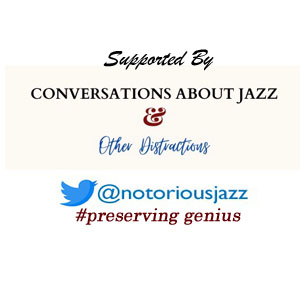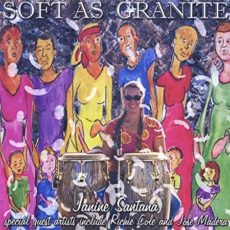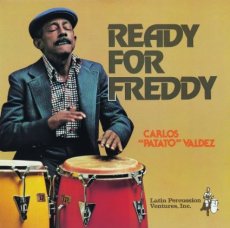
Daily Dose Of Jazz…
Armando Peraza was born May 30, 1924 in Lawton Batista, Havana, Cuba and was orphaned by age 7 and lived on the streets. By twelve he was supporting himself by selling vegetables, coaching boxing, playing semi-pro baseball, and becoming a loan shark. His music career began at seventeen when he heard at a baseball game that bandleader Alberto Ruiz was looking for a conga player and Ruiz’s brother was on the same baseball team as him. Despite the absence of experience in music, he practiced and won the audition.
He left Cuba for Mexico in 1948 to tend to his sick friend, conga drummer Mongo Santamaría. They arrived in New York City in 1949 and after playing in Machito’s big band, Peraza was invited by Charlie Parker to participate in a recording session that included Buddy Rich. He recorded with Slim Gaillard in New York Cuty in 1949 in a session that produced Bongo City and toured the U.S. with him band until they reached San Francisco, California. He spent time in Mexico recording with Perez Prado and did some soundtracks for the Mexican movie industry.
Returning to the U.S. he settled in San Francisco, worked with Dizzy Gillespie, toured extensively with Charles Mingus and Dexter Gordon, and played with Puerto Rican actor and musician Tony Martinez. Armando led an Afro-Cuban dance review at the Cable Car Village Club in San Francisco, attracting a clientele from Hollywood that included Errol Flynn, Marlon Brando, and Rita Hayworth.
By 1954, he was working with pianist Dave Brubeck, Peraza met Cal Tjader, and jazz critic Leonard Feather recommended Peraza to Fantasy Records to record an Afro-Cuban album with Tjader. The result was Ritmo Caliente, which combined Afro-Cuban rhythms with a jazz sensibility. Following this he met George Shearing through bassist Al McKibbon and he spent the next twelve years with the pianist, a collaboration that put Peraza at the forefront of Afro-Cuban music.
Armando emerged as a composer, writing and recording twenty-one songs for Shearing, such as Mambo in Chimes, Mambo in Miami, Ritmo Africano, Armando’s Hideaway, This is Africa, and Estampa Cubana. These recordings were during the mambo craze in the U.S. and the world. In 1959, he joined Mongo Santamaría for the Mongo album, then became a member of Cal Tjader’s band for six years, followed by a stint with drummer Shelly Manne.
He recorded one solo album, Wild Thing, was the first Afro-Cuban percussionist to add conga drums to a rock track, an in 1972, at the age of 47, Peraza joined the rock band Santana, influencing andtrmining for nearly twenty years and played to millions of people around the world, partnering with percussionists José Areas, Mingo Lewis, Raul Rekow, and Orestes Vilató. He wrote or co-wrote sixteen songs recorded by Santana.
Peraza retired from Santana in 1990 at the age of 66, played a Santiago de Chile concert with Santana in 1992, returned to Cuba after fifty year absence in 202, and recorded on the John Santos, 20th Anniversary in 2005, At 82 years of age, in 2006 he made a rare appearance with Santana for a three show performance at the Montreux Jazz Festival in Switzerland. In 2007, he received a Lifetime Achievement Award from the Voices of Latin Rock, who present the Armando Peraza Award for achievement in the San Francisco Bay Area every year.
On April 14, 2014 Latin jazz percussionist Armando Peraza who played congas, bongos, and timbales transitioned from complications of pneumonia. He was 89.
More Posts: bongo,conga,history,instrumental,jazz,music,timbales

Daily Dose Of Jazz…
Rafael Antonio Cortijo was born on December 11, 1928 in Santurce, Puerto Rico and as a child became interested in Caribbean music and enjoyed the works of some of the era’s most successful Bomba y Plena music musicians. Throughout his life, he had a chance to meet and work with some of them and learned how to make his own congas and pleneras, the handheld drums used in bomba y plena music.
He met salsa composer and singer Ismael Rivera when both were youngsters growing up in the Villa Palmeras neighborhood. They became lifelong friends and Rivera impressed with his friend’s conga-playing skills, asked him to join his orchestra, which played at Fiestas patronales all over Puerto Rico.
Becoming well known across Latin America, Rafael attributed his success to the sound of his percussion, as Afro-Caribbean music was known worldwide. As a member of the Conjunto Monterrey, based in Monterrey, Mexico, he later toured with Daniel Santos’ orchestra and worked on radio.
By 1954, as a member of El Combo, Cortijo’s big break came when El Combo’s leader and pianist Mario Román left the band to him. Ismael Rivera, then the lead singer of Lito Peña’s Orquesta Panamericana, joined Cortijo’s orchestra known as Cortijo y su Combo in 1955. From then until 1960, his orchestra played live on Puerto Rican television shows, and sometime during the 60s, they became the house band at La Taberna India.
The orchestra virtually disbanded in 1962 when Ismael Rivera was arrested for drug possession in Panama. Rafael and the other bandmates went on to found Puerto Rico’s salsa group, El Gran Combo. He went on to create another orchestra, El Bonche, where he was joined by his adopted niece, Fe Cortijo, who would become a well-known singer on her own. He and Rivera went on to live in New York City but he soon returned impoverished to Puerto Rico, where he forged a friendship with composer Tite Curet Alonsothe who helped produce a comeback album. In 1974, Coco Records reunited all the former members of “Cortijo y su Combo” orchestra for a one-time-only concert and a subsequent studio recording issued a few months afterward.
Their friendship was so important to Rivera, that when orchestra leader, musician, and composer Rafael Cortijo passed away of pancreatic cancer on October 3, 1982 at his sister Rosa Cortijo’s apartment in the Luis Llorens Torres public housing project in Santurce, Rivera said he would no longer sing.

More Posts: bandleader,conga,history,instrumental,jazz,music

Daily Dose Of Jazz…
Janine Santana was born January 28th in Brooklyn, New York of Puerto Rican and Finnish ancestry and spent her childhood in Brooklyn and youth in Trenton, New Jersey. She developed a love for Afro-Cuban/ Caribbean traditions and Jazz and began working and studying as a professional actor at a very young age, long before studying music at Aims Community College.
A 1994 move to Denver, Colorado focused her more on performance, music recording and broadcasting. She leads a 6-12 piece Latin Jazz Ensemble and her well received 2009 recording Soft as Granite had Janine working with alto saxophonist Richie Cole, trumpeters Greg Gisbert and Brad Goode, and arranger/percussionist José Madera.
Conguera, percussionist, leader, arranger, studio musician, broadcaster, artist, designer, writer and actor Janine Santana currently continues to perform, record and collaborating with generations of jazz and Latin jazz musicians on a brand new project with the likes of Luques Curtis, Bobby Porcelli, David Amram, Jose’ Madera on timbales and arrangements, Ricky Gonzalez as producer/pianist/arranger and Ray Vega on trumpets.
![]()
#preserving genius
More Posts: conga,percussion

Daily Dose Of jazz…
Tata Güines was born Federico Arístides Soto Alejo on June 30, 1930 in, the poor town of Güines east of La Habana in the province of Havana in Cuba. He made his first drums out of milk cartons and sausages. But, by the 1950s he was working with such top Cuban musicians as Arsenio Rodriguez, Luciano “Chano” Pozo, Bebo Valdes, and Israel “Chachao” Lopez.
In the late 1950s he formed a band with the pianist Frank Emilio Flynn called Quinteto Instrumental de Musica Moderna, which was later changed to Los Amigos. Güines moved to New York City in 1957 and quickly immersed himself in the jazz scene paying with Dizzy Gillespie, Maynard Ferguson and Miles Davis at Birdland. As a percussionist, he performed with Josephine Baker and Frank Sinatra.
Tata returned to Cuba in 1959 after Fidel Castro came to power in the Cuban Revolution which he helped fund by contributions from his earnings as a musician. For a while instrumentalists fell out of favor with the Cuban public and his popularity diminished. However, by 1979 his star began to shine once again with his work in the Estrellas de Areito sessions, recording for Egrem, the Cuban state record company, which revived the old descarga style.
By the 1990s, he was considered an old master and frequently toured. He recorded with the young conguero Miguel Diaz on the 1995 Pasaporte that garnered them the Egrem Album of the Year award, the equivalent of a Grammy in Cuba. He has played with pianist Bebo Valdes and singer Diego El Cigala Lágrimas Negras (Black Tears) that won a Latin Grammy, and has performed with saxophonist Jane Bunnett.
Conguero and tumbadora player, percussionist and composer Tata Güines, who during his career spanning six decades was known as the “King of the Congas” and who was important in the first generation of Afro-Cuban jazz, passed away on February 4, 2008 in his hometown of Havana.
More Posts: conga,percussion

Daily Dose Of Jazz…
Carlos “Patato” Valdes was born on November 4, 1926 in Cuba and learned to play the conga in his native land. Moving to New York in 1954 he began playing around the city working with Willie Bobo in Harlem. Known by his nickname “Patato”, he invented and patented the tunable conga drum in the late Forties that revolutionized use of the instrument as earlier drums only had nailed heads.
Since the 1950s Patato is among the Congueros that were in highest demand in the Latin Music and jazz world. He played, toured and recorded together with singer Miguelito Valdes, Perez Prado, Tito Puente, Machito, Herbie Mann, Cachao Lopez, Cal Tjader, Kenny Dorham, Art Blakey and Elvin Jones among others. He also worked in the bands of and toured Europe with Dizzy Gillespie, Quincy Jones and Mario Bauza.
Patato acted in and composed the title song of The Bill Cosby Show, contributed to the soundtrack of the film The Mambo Kings Play Songs of Love, gave Bridget Bardot mambo lessons in the film “And God Created Woman, led his own band Afrojazzia and toured Europe once again and mastered to the delight of his audiences, the art of actually dancing atop his congas during his performances.
For over 60 years Valdes demonstrated in his conga playing how a musician could combine technical skill with superb showmanship, fusing melody and rhythm, and understanding the rhythm is rooted in dancing. Carlos “Patato” Valdes, whose spontaneity and charm enabled him to bring together audiences of varied backgrounds and cultures to the Afro-Cuban rhythms and who Tito Puente once referred to as “the greatest conguero alive today”, passed away on December 4, 2007 in New York City.
More Posts: conga



